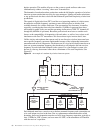86 Handbook of Intercom Systems Engineering
(now often called HTs or Handie-Talkies) have higher operating power which affords
substantially increased operating range of over a mile or more in some cases. This range
can be increased to cover an entire city by the use of repeater stations located at the top of
centrally located buildings.
Two-way radios did not, however, do as well for the rigors of live television production. In
live TV, the restrictive nature of HTs was only too evident. First, HTs utilize a half-duplex
communication scheme. Half-duplex means that while there is bi-directional conversation,
only one user may communicate at a time and all other users must listen until the person
who is communicating is finished. During setup this does not pose a huge problem, but
during a show, when seconds can seem like hours, this can be a real problem. Imagine a
cameraman is transmitting over a half-duplex HT system, while the director is trying to
take a new shot or make some other time-critical change. Obviously, a half-duplex system
would never do.
Soon after it became apparent that a half-duplex communications system would never
satisfy the needs of on-air production, a vast array of new HT-based system configurations
emerged. The greatest of these utilized two HTs on each user and multiple base station
units in a complex repeater configuration. An interface box allowed users to wear one
headset that fed both radios at once. While achieving some of the functionality of the most
basic modern day wireless intercom, the system was bulky, heavy and unreliable due to
the numerous wires and complexity of setup. While this system was much closer, it still
did not offer communications professionals the robust functionality and reliability they
needed for day-to-day operations.
The next generation of wireless intercoms to hit the scene was truly a breakthrough. It
eliminated much of the complex wiring and minimized the equipment the user was forced
to wear. The system consisted of a base station and multiple user beltpack pairs. In the
base station there was a single transmitter and multiple receivers (one for each wireless
user). The audio coming from each receiver was put on a single intercom channel or audio
bus, and was fed to the transmitter as well as an external intercom line. The transmitter
was a low power, always on unit that maintained constant outgoing information to all
wireless users. See Figure 6.1.


















